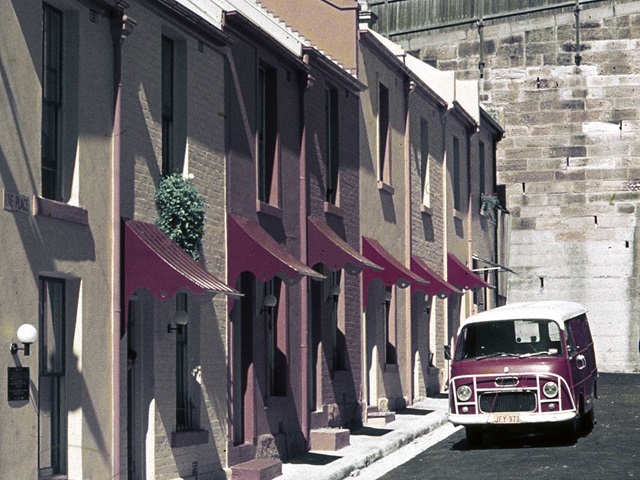History of Customs House
A historic Sydney landmark representing regulation, trade and revenue in an evolving city.

Customs House is one of Sydney's historic landmark buildings, which has featured in the working and cultural life of the city since it was built in 1845. For over 150 years, Customs House played an active role as the primary trade gateway for goods and people flowing into Sydney and Australia. It continues to play an important role as a community space in modern-day Sydney.
Customs House is on Gadigal Country. For thousands of generations the Gadigal of the Eora Nation have lived and traded around this harbour cove. The Aboriginal flag is now flown permanently from the building.
For many years Customs House was not only a focal point for trade, the building and the square in front of it also provided a focus for major national celebrations. Customs House and Customs Square continue to host numerous cultural events and exhibitions.
Customs officials were the minders of money and morals. The Collector of Customs oversaw the increasingly complicated administration of shipping, trade and immigration. Customs clerks worked in Customs House, on every ship, on the wharves and in the bonded warehouses.
The original 2-storey sandstone building was designed by colonial architect Mortimer Lewis. It was expanded and modified over the years to meet the regulatory requirements of customs officials. The current Customs House embodies the work of 4 major government architects, as well as modern conservation architects.
Customs House was once surrounded by public houses, shipping companies and general maritime activities. When the port was busy, Customs House was crowded and noisy, the scene of disputed dealings and raised tempers. By the 20th century the bustling quay, with its tram and ferry network, had become a symbol of the city and a tourist attraction.
Detection of smuggling and contraband goods were all in a day’s work for diligent customs officials. Incoming ship manifests had to correctly describe their cargo for the payment of duties (or taxes). Every nook and cranny of a ship was searched and scrutinised. The collection of excise and duty on goods was the chief form of government revenue for over a century and bankrolled the development of the nation. Customs regulations also controlled medicinal and illicit drugs, passports, patents and trademarks, copyright, and plant and animal quarantine. One constant question from customs officials has interrogated passengers across the decades: ‘Anything to declare?’
The Australian Customs Service used the building until 1990. The federal government leased the building to the City of Sydney in 1994 and in 2019 the City of Sydney bought the building.
- 1843–1845: Customs House was designed by Mortimer Lewis and built on the waterfront. The jagged line of dark granite in the square marks the original highwater mark.
- 1883–1889: Customs House was enlarged by James Barnet. He added a grander portico entrance, an extra floor, a clock and 2 wings along the sides.
- 1896–1903: Walter Liberty Vernon oversaw extensions to Customs House.
- 1903: Customs House now had 5 floors, a colonnaded balcony and exuberant decoration in the French neoclassical style.
- 1915–1917: George Oakeshott introduced further floorspace and a lift. The most visible modifications to the public were the foyer redesign and a caretaker’s flat on the roof.
The City of Sydney has an array of symbols and motifs within its public buildings that have a historical context and meaning that dates back over 100 years.
Inlaid into the terrazzo floor at the entrance to Customs House are decorative emblems that many recognise as swastikas. Today this symbol is most commonly identified with the German Nazi party and their abhorrent racial persecution leading up to and during World War 2.
In fact, this motif has a much longer history and for many cultures is a symbol of peace and prosperity. It appears in cultures across Asia and Europe, including ancient Greece and modern India. It was only adopted by the Nazi party in 1920 and was banned in Germany following World War 2.
The 16 black swastikas decorating the terrazzo floor in Customs House foyer were selected by the architect George Oakeshott during a major reconstruction of the building in 1915to 1917 as classical ornamentation, in keeping with the architecture of the building. This stylised decoration was also used in other financial and retail buildings in this era. The Australian Customs Service covered over the floor because of the symbol’s associations during World War 2. The ornamental floor was revealed once more to the public when the building was refurbished in the 1990s.
City of Sydney is aware of these motifs in the floor of Customs House, and research is underway to better understand and interpret them for contemporary audiences.
![John Ward, Alfred Street, Circular Quay, 1968 (01/10/1968), [A-01112536]. City of Sydney Archives, accessed 29 Sep 2023,](https://www.cityofsydney.nsw.gov.au/-/jssmedia/corporate/images/places-and-spaces/landmarks/custom-house/history/john-ward-299-busestif.jpg?mw=640)
![Sydney's Customs House, Alfred Street Circular Quay, 1928 (01/01/1928 - 31/12/1928), [A-00006267]. City of Sydney Archives, accessed 29 Sep 2023.](https://www.cityofsydney.nsw.gov.au/-/jssmedia/corporate/images/places-and-spaces/landmarks/custom-house/history/000334tif.jpg?mw=640)
![Customs House, Alfred Street Sydney, 1903 (01/01/1903 - 31/12/1903), [A-00011580]. City of Sydney Archives, accessed 29 Sep 2023.](https://www.cityofsydney.nsw.gov.au/-/jssmedia/corporate/images/places-and-spaces/landmarks/custom-house/history/031422tif.jpg?mw=640)


